Vuelta 2022 route and stages: What’s in store for Primoz Roglic, Remco Evenepoel and rivals in Spain?
Two years after La Vuelta was supposed to start in Utrecht, the race finally gets its Dutch ‘gran salida’ after Covid forced the organisers into some eleventh-hour changes in 2020. After the Giro’s start in Budapest and the Tour in Copenhagen, Utrecht completes the Grand Tour grand slam of foreign starts on a Friday for 2022 with each of cycling’s major three-week stage races having an additional rest day to compensate for the journey back to home soil.
The 77th edition of La Vuelta begins with a team time trial and two road stages in the Netherlands. The first major summit finish comes on the Pico Jano in Stage 6 ahead of back-to-back summit showdowns in Asturias on the second weekend. Week two of the race gets going with a 30.9km individual race of truth on the Costa Blanca before the race edges across southern Spain and then towards the centre of the country ahead of the finish in Madrid.
In total there are seven summit finishes including Les Praeres (where Simon Yates secured his overall win in 2018), La Pandera, Penas Blancas, the Alto del Piornal and the Alto Hoya de la Mora in Sierra Nevada – the highest peak of the race at 2,512m.
Vuelta a España
‘We are delighted’ – Roglic passed fit to race at Vuelta just 10 days after returning to training
A DAY AGO
With six potential bunch sprints on the cards as well as several days ideally suited for the breakaway specialists, it’s a race that caters for all sorts of riders. It’s also one that a fully-fit triple champion Primoz Roglic will love – provided he’s over the knock he received during the Tour de France.
Before a run-through of each stage, here is a brief summary of what’s in store over the next three and a bit weeks in the Netherlands and in Spain.
| Stage 1: Fri Aug 19 | Utrecht – Utrecht | 23.2km (TTT) |
| Stage 2: Sat Aug 20 | ‘s-Hertogenbosch – Utrecht | 175.1km (Flat) |
| Stage 3: Sun Aug 21 | Breda – Breda | 193.5km (Flat) |
| Rest day: Mon Aug 22 | ||
| Stage 4: Tue Aug 23 | Votoria-Gasteiz – Laguardia | 152.5km (Medium mountains) |
| Stage 5: Wed Aug 24 | Irun – Bilbao | 187.2km (Medium mountains) |
| Stage 6: Thu Aug 25 | Bilbao – Pico Jano (San Miguel de Aguayo) | 181.2km (Summit finish) |
| Stage 7: Fri Aug 26 | Camargo – Cistierna | 190km (Medium mountains) |
| Stage 8: Sat Aug 27 | La Pola Llaviana – Collau Fancuaya | 153.4km (Summit finish) |
| Stage 9: Sun Aug 28 | Villaviciosa – Les Praeres | 171.4km (Summit finish) |
| Rest day: Mon Aug 29 | ||
| Stage 10: Tue Aug 30 | Elche – Alicante | 30.9km (ITT) |
| Stage 11: Wed Aug 31 | ElPozo Alimentacion – Cabo de Gata | 191.2km (Flat) |
| Stage 12: Thu Sep 1 | Salobrena – Penas Blancas | 192.7km (Summit finish) |
| Stage 13: Fri Sep 2 | Ronda – Montilla | 168.4km (Flat-ish) |
| Stage 14: Sat Sep 3 | Montoro – Sierra de La Pandera | 160.3km (Summit finish) |
| Stage 15: Sun Sep 4 | Martos – Alto Hoya de la Mora, Sierra Nevada | 149.6km (Summit finish) |
| Rest day: Mon Sep 5 | ||
| Stage 16: Tue Sep 6 | Sanlucar de Barrameda – Tomares | 189.4km (Flat) |
| Stage 17: Wed Sep 7 | Aracena – Monasterio de Tentudia | 162.3km (Uphill finish) |
| Stage 18: Thu Sep 8 | Trujillo – Alto del Piornal | 192km (Summit finish) |
| Stage 19: Fri Sep 9 | Talavera de la Reina – Talavera de la Reina | 138.3km (Medium mountains) |
| Stage 20: Sat Sep 10 | Moralzarzal – Puerto de Navacerrada | 181km (Mountains) |
| Stage 21: Sun Sep 11 | Las Rozas – Madrid | 96.7km (Flat) |
Stage 1: Utrecht – Utrecht, 23.2km (TTT)
The Vuelta’s once-favoured opening team time trial returns for the first time since 2019. It’s longer than previous TTTs, entirely pan-flat and not that technical, despite no fewer than 29 turns and two roundabouts.
Some long straights should give the upper hand to the more powerful teams, but the gaps should not be huge – so we won’t be writing off the chances of Enric Mas and Miguel Angel Lopez on day one.
Stage 2: ‘s-Hertogenbosch – Utrecht, 175.1km (Flat)
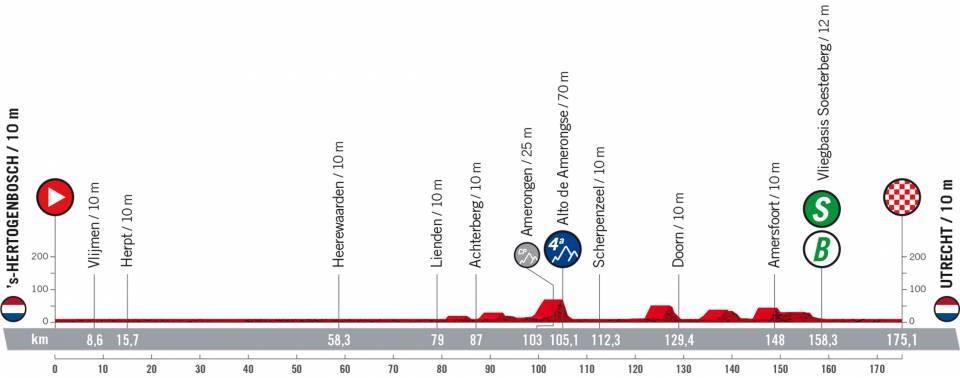
A sprint stage that could be spiced up by coastal winds – although that would be something of an anomaly for Grand Tours in 2022. One little lump – to the dizzying heights of 70m – will determine whose shoulders will sport the race’s first blue polka dot jersey.
Stage 3: Breda – Breda, 193.5km (Flat)

The third and final stage in the Netherlands is an anti-clockwise loop to and from Breda which twice kisses the Belgian border. You know the organisers are scraping that barrel when the day’s highest point is just 25 metres above sea level and yet deemed worthy of fourth-category status.
Stage 4: Vitoria-Gasteiz – Laguardia, 152.5km (Medium mountains)

The first stage on mainland Spain gives us more of a traditional Vuelta stage with numerous lumps and bumps ahead of the race’s first uphill sprint finish. The summit of the third-category Puerto de Herrera comes just 14km from the finish and could well prove to be the springboard.
The ramp to the line (800m at almost 10%) flattens for what should be a reduced bunch dash for this all-Basque stage that passes through towns called Landa and Quintana…
Stage 5: Irun – Bilbao, 187.2km (Medium mountains)
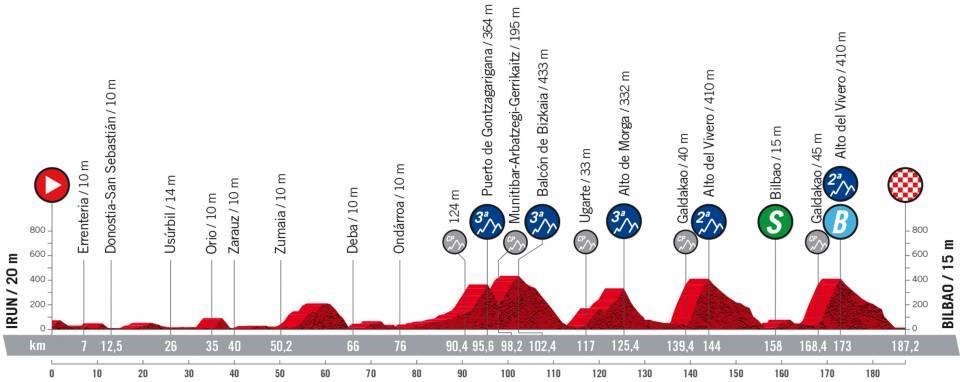
More lumps and bumps through the Basque region ahead of a flat and fast finish in Bilbao. The route largely hugs the Atlantic coast as it passes through San Sebastian ahead of three Cat.3 ascents that precede the finale: two laps around Bilbao including a dual ascent of the Cat.2 Alto de Vivero.
This could be an exciting day that caters neither for the GC men nor the sprinters. A similar finish in 2016 saw Jens Keukeleire take the spoils.
Stage 6: Bilbao – Pico Jano (San Miguel de Aguayo), 181.2km (Mountains)
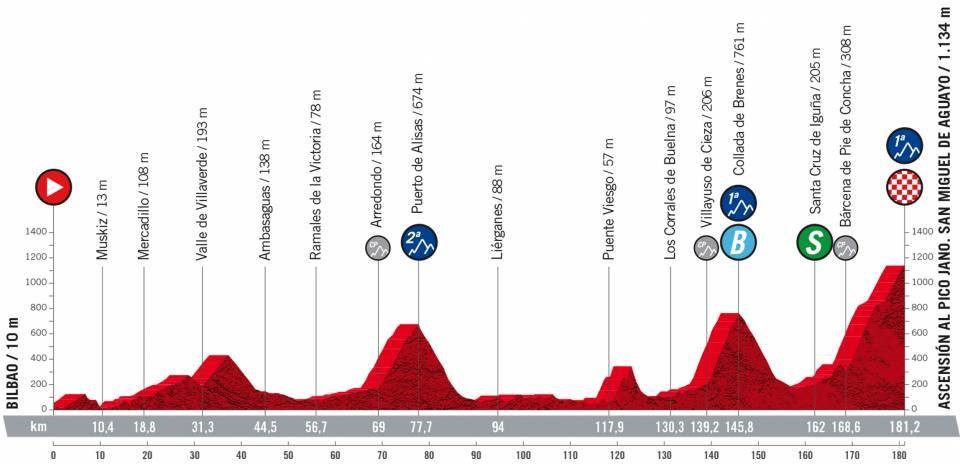
The first summit finish of the race and the first major climbs should shuffle the pack and coax out the genuine GC contenders, although it could well be a breakaway that goes the distance and battles for the win on the Pico Jano – a largely benign 12.6km pass being used for the first time in Vuelta history.
Before that, the shorter but harder Collada de Brenes with its two 15% ramps and less forgiving average gradient of 8.2% should prove a sterner test.
Stage 7: Camargo – Cistierna, 190km (Medium mountains)
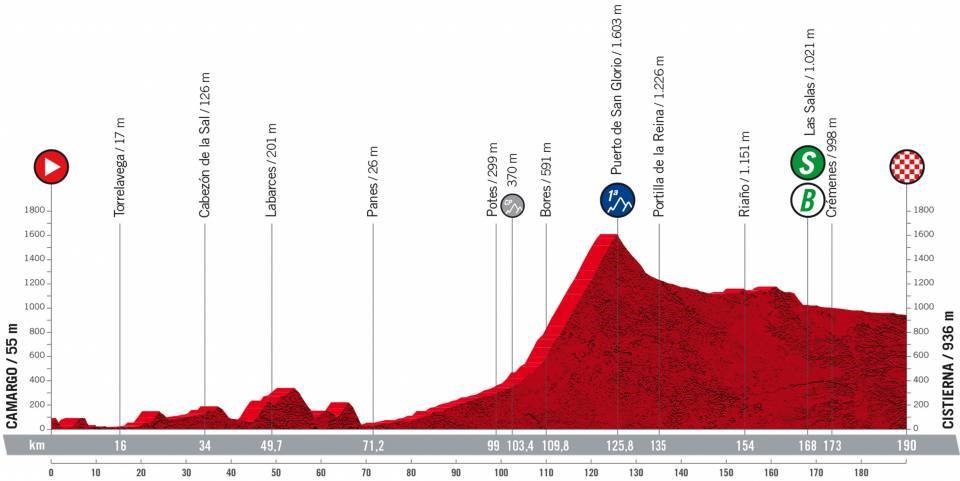
This intriguing stage could either be a humdinger or a right snore-fest depending on how the riders decide to attack it. Rolling roads above the coast over the opening 70km could see sparks fly and a strong break form ahead of a long and seemingly interminable Cat.1 ascent of the Puerto de San Glorio. Averaging 5.5% and well over 20km long, it’s a very un-Vuelta type climb.
After a short descent to an inland plateau, it’s still another 55km of largely slightly downhill riding to the finish in Cistierna where your guess is as good as mine as to what may happen.
Stage 8: La Pola Llaviana – Collau Fancuaya, 153.4km (Mountains)
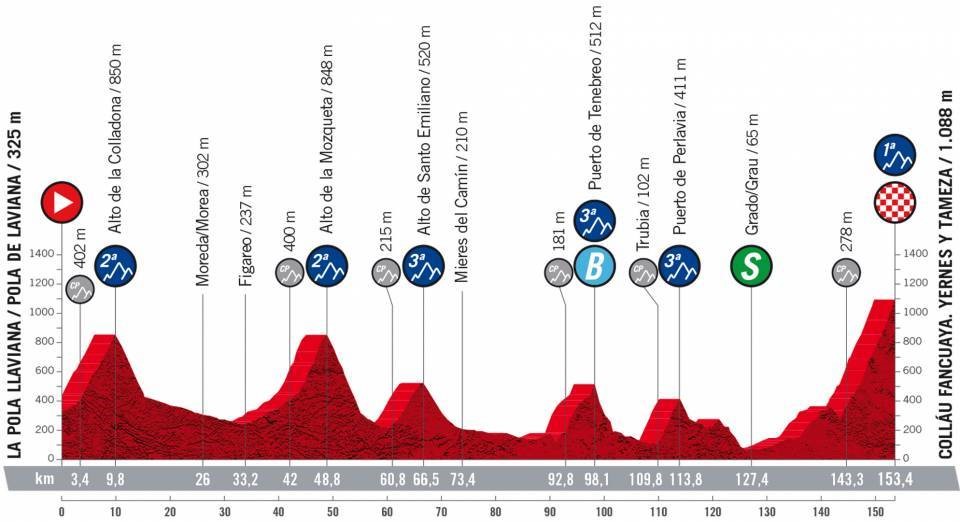
The first of back-to-back weekend summit finishes in Asturias ahead of the second rest day features over 3,300m of climbing. Five categorised climbs precede the final slog of the Cat.1 Collau Fancuaya, where finding the right rhythm will be tough on an ever-changing gradient described by one source as “inhumane”.
The narrow and gritty 10km climb is being used for the first time in the Vuelta and includes a vicious segment of 19% halfway up, an average gradient of 8.5% and a tough closing 2km with ramps reaching 17%.
Stage 9: Villaviciosa – Les Praeres, 171.4km (Mountains)
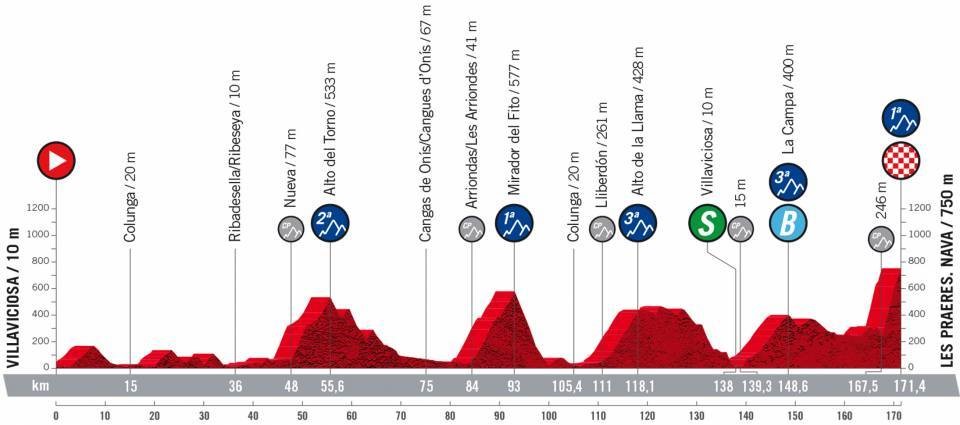
When the Vuelta last had a stage that finished on the Les Praeres de Nava the win went to Simon Yates ahead of Miguel Angel Lopez and Alejandro Valverde, the British climber going back into the red jersey that he would wear all the way to Madrid. Four years on and the profile is slightly different with four tough climbs preceding the final test, including the Cat.1 Mirador del Fito.
Les Praeres de Nava is less than 4km long but packs a punch with relentless double-digit gradients and a maximum tilt of 24%.
Stage 10: Elche – Alicante, 30.9km (ITT)
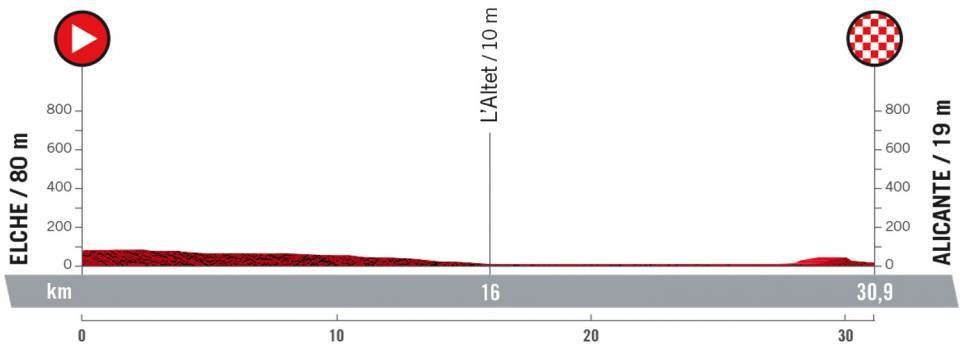
The second full week of the race gets under way with this pan-flat time trial that suits the pure specialists. With long straights, fewer than 10 turns, and a negative altitude gain, this will be a fast course where the time losses could be quite large for the pure climbers and mountain goats. An exposed section along the Levante coast could be windy and slightly problematic.
Stage 11: ElPozo Alimentacion – Cabo de Gata, 191.2km (Flat)

Ah yes, the annual keep-the-sponsors-sweet start at an out-of-town supermarket. This town, although you wouldn’t know it, is Alhama de Murcia, nestled between the Sierra de Carrascoy and Sierra Espuna mountain ranges, neither of which the race enters.
Instead, it’s a flat slog south and along the coast, passing though arid desert land and ugly acres of plastic polytunnels growing fruit ahead of a likely bunch sprint in the tiny town of Cabo de Gata, east of Almeria. If you must miss one stage, this is probably it.
Stage 12: Salobrena – Penas Blancas, 192.7km (Medium mountains)
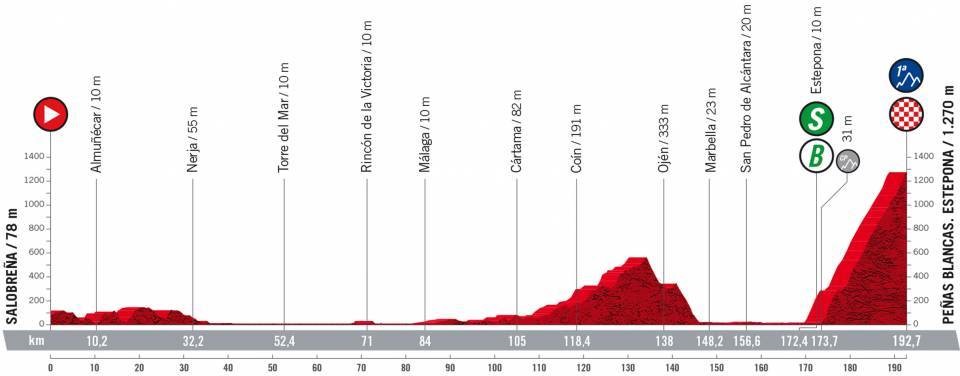
A tale of two halves: a flat opening 110km along the coast around Malaga ahead of an uncategorised climb up to 600m, a two-tier descent, more flat coastal roads past Marbella and beyond, then the final Cat.1 ascent to the finish.
The Penas Blancas climb has featured in the Vuelta before but an extra 4km have been added to the end, making it 19km at 6.7%. The climb rises from sea level and the opening 3km are the toughest – but its length, combined with the heat, could take its toll.
Stage 13: Ronda – Montilla, 168.4km (Flat)
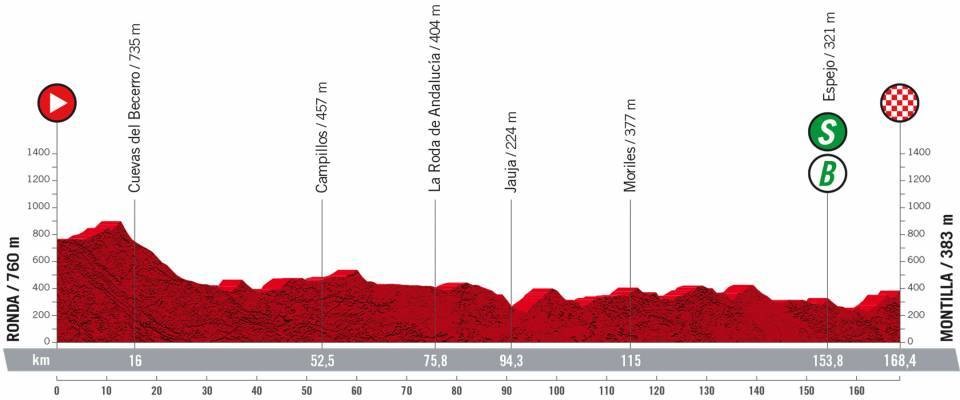
With no categorised climbs, this is one of those stages deemed “flat” by the organisers – although the road goes up and down consistently as it heads north to Montilla, where the finish is on a kilometre-long uphill ramp. It would be a surprise if a sprinter wins this one.
Stage 14: Montoro – Sierra de La Pandera, 160.3km (Mountains)
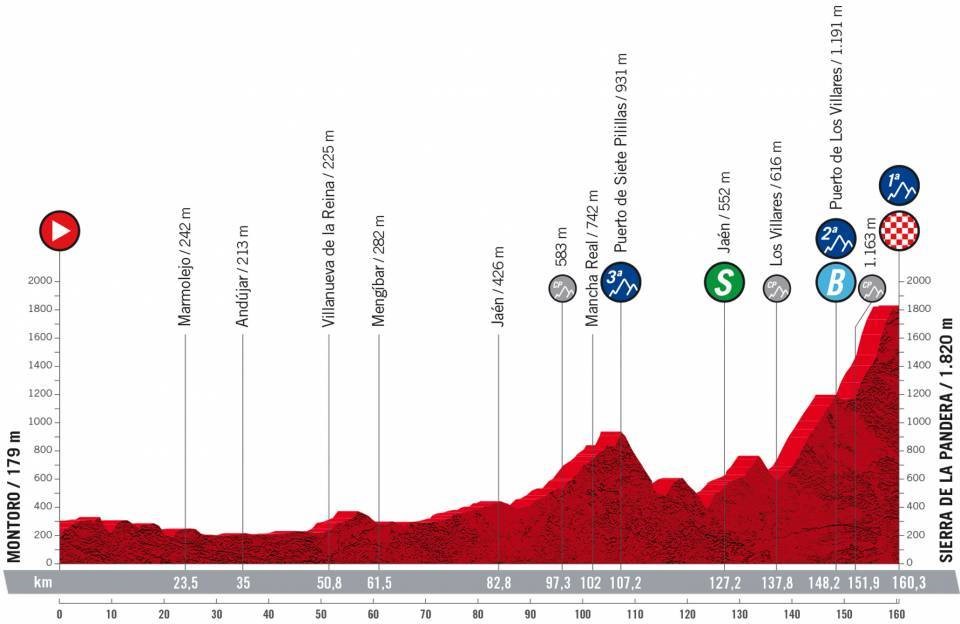
The Vuelta returns to La Pandera for the first time in five years for a finish beside the military station in the Sierra Sur de Jaen mountain range. The tough final climb plays out on a narrow and twisting road made up of concrete slabs and comes right after the Cat.2 Puerto de Los Villares with hardly even a descent separating the two. That makes for almost 20km of climbing, with the gradient rising to 15% on three occasions.
Should Alejandro Valverde win here it will be 19 years after his victory on the same climb in 2003, which marked the eighth win of his career and his second of 12 stage successes in La Vuelta.
Stage 15: Martos – Alto Hoya de la Mora, Sierra Nevada, 149.6km (Mountains)
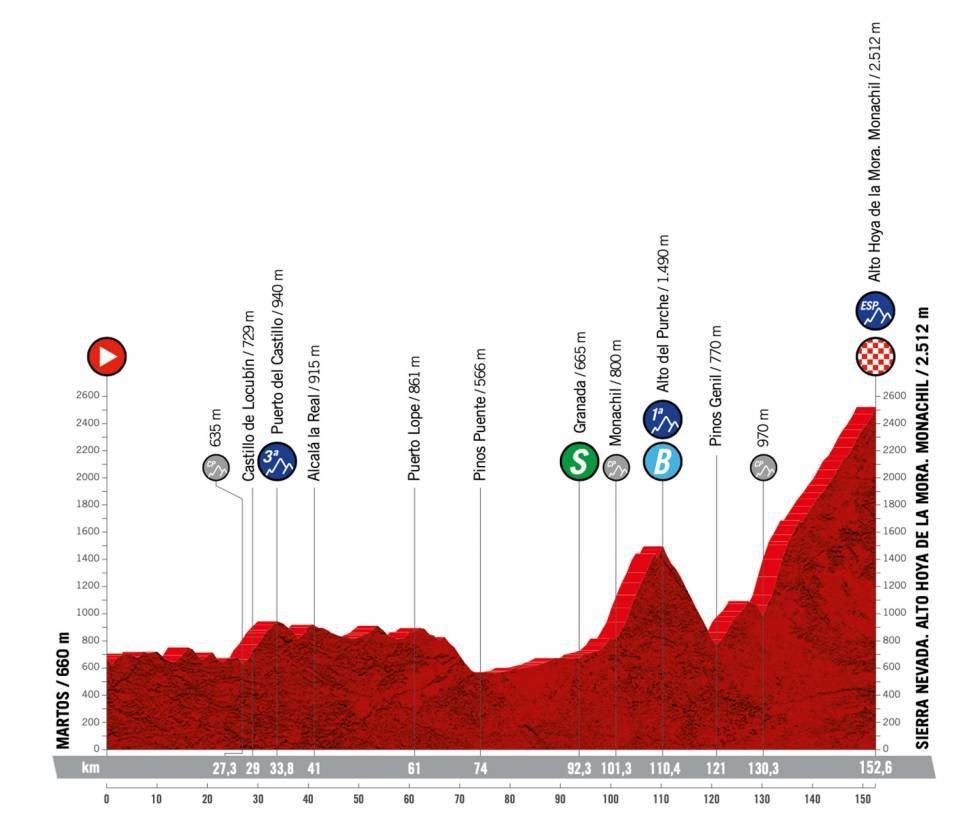
The last stage before the second rest day culminates with the race’s first ‘Especial’ climb, the Alto Hoya de la Mora in the Sierra Nevada range – at 2,512m, the highest climb of the race and the only time the riders venture above 2,000m. Two tough ascents and many hills precede the final 22.1km test, for which the opening quarter is by far the hardest with the road rising to 20%.
Colombia’s Miguel Angel Lopez won on the Alto Hoya de la Mora when the race last visited in 2017 but the approach to the top was via a larger, gentler road. What’s more, just days before the ‘gran salida’ the organisers have added an extra 3km extension onto the climb – taking it up from its initial 19.3km length at an average gradient of 6.7%.
Stage 16: Sanlucar de Barrameda – Tomares, 189.4km (Flat)
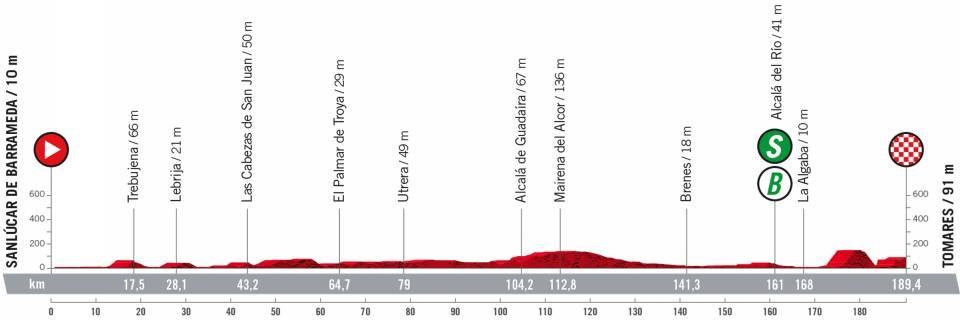
Compared to the Tour, there’s much more joy for the sprinters at this Vuelta. Today’s tortilla-flat stage spirits the riders north and then around Sevilla on a loop before the finish in the western outskirts at Tomares where a short but sharp ramp 3km from the finish may separate the sprinting chaff from the wheat ahead of a finish that rises gradually to the line.
Italy’s Matteo Trentin won here five years ago – and this will be the last opportunity for the fast men before the final stage in Madrid.
Stage 17: Aracena – Monasterio de Tentudia, 162.3km (Uphill finale)
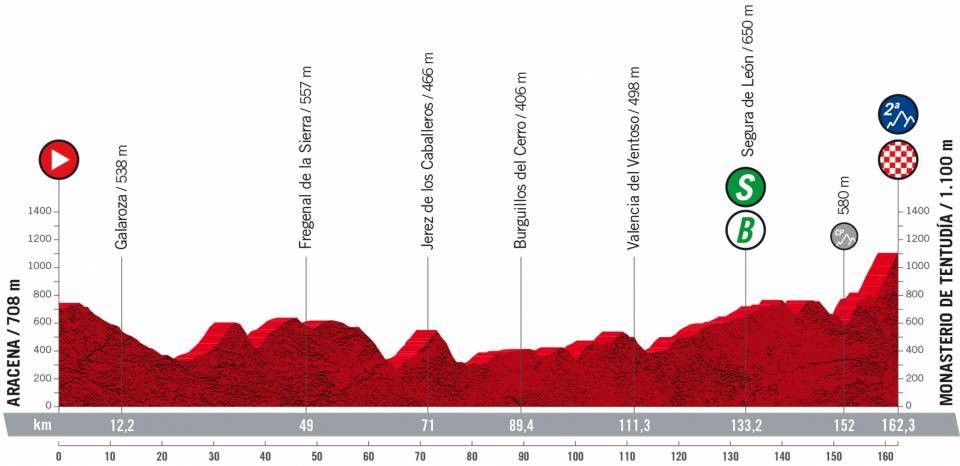
The official site describes this one as ‘flat’ which is a bit like saying the Angliru is a sprint. While there are no categorised climbs before the final Cat.2 rise to the finish, there’s well over 1,200m of altitude gain along the way in the sweltering Extremadura region before the ascent to the Monasterio de Tentudia which, while only 5% over 10km includes some double-digit segments as well as a short downhill section which skewers the stats somewhat. Not for the sprinters.
Stage 18: Trujillo – Alto del Piornal, 192km (Mountain)
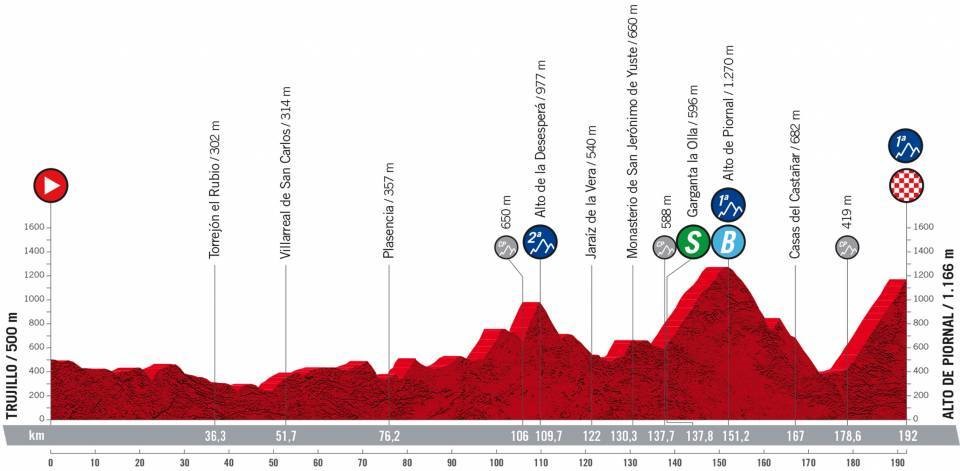
Three different ways up the Piornal crown this tricky stage which should prove a key battle for the red jersey. The first ascent is via the Alto de la Desespera (3.7km at 9.4%), then the climb is tackled via the traditional approach past the Monastery of Yuste (13.5km at 5%) before a final climb via the Jerte valley (also 13.5km at 5%). None of the three are particularly challenging taken in isolation, but at the end of a long stage and amid a leg-sapping final week, there could be some damage.
Stage 19: Talavera de la Reina – Talavera de la Reina, 138.3km (Medium mountains)
La Vuelta 2022 – Stage 19 route profile
Image credit: Eurosport
There’s something of a vintage Madonna lying on her back for this short but challenging day in the medium mountains with two pointy ascents of the Cat.2 Puerto del Pielago preceding a fast descent and flat run back to the start and finish town, which is renowned for its pottery (apt, given the potentially kiln-like temperatures). It’s essentially two identical anti-clockwise loops north of Talavera de la Reina where the riders will know exactly what to expect the second time around.
Stage 20: Moralzarzal – Puerto de Navacerrada, 181km (Mountains)
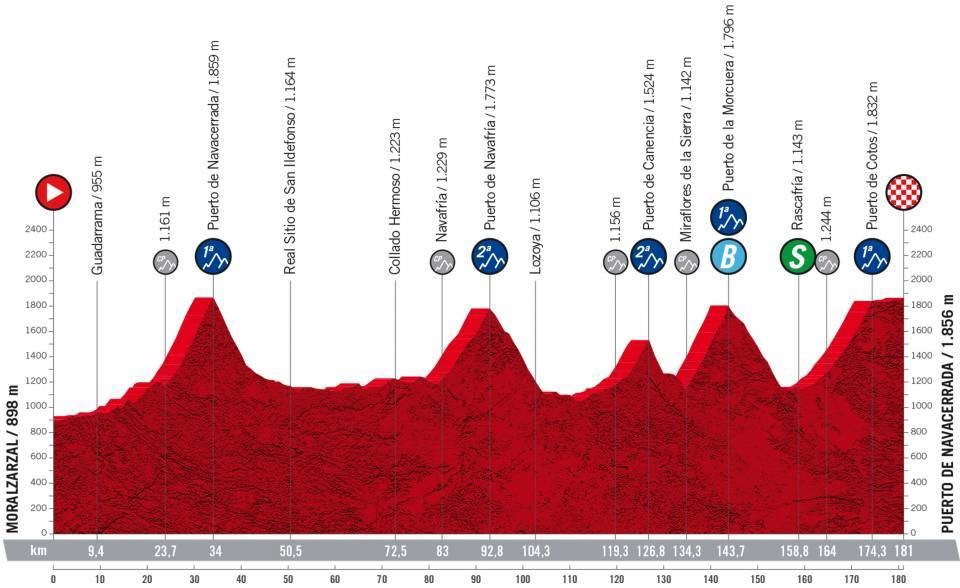
The final mountain test of the 77th edition is not a summit finish as such because the finish comes some 6km after the summit of the fifth climb of the day, the Puerto de Cotos. This intriguing ride through the Guardarrama mountain range is similar to the penultimate stage in 2015 when Fabio Aru seized the red jersey off the shoulders of Tom Dumoulin at Cercedilla.
Two ascents of the Puerto de Navacerrada bookend this final test, the second of which via the Puerto de Cotos. None of the gradients are particularly feisty but after three hard, hot weeks, we can’t rule anyone out from suffering like Dumoulin seven years ago.
Stage 21: Las Rozas – Madrid, 96.7km (Flat)
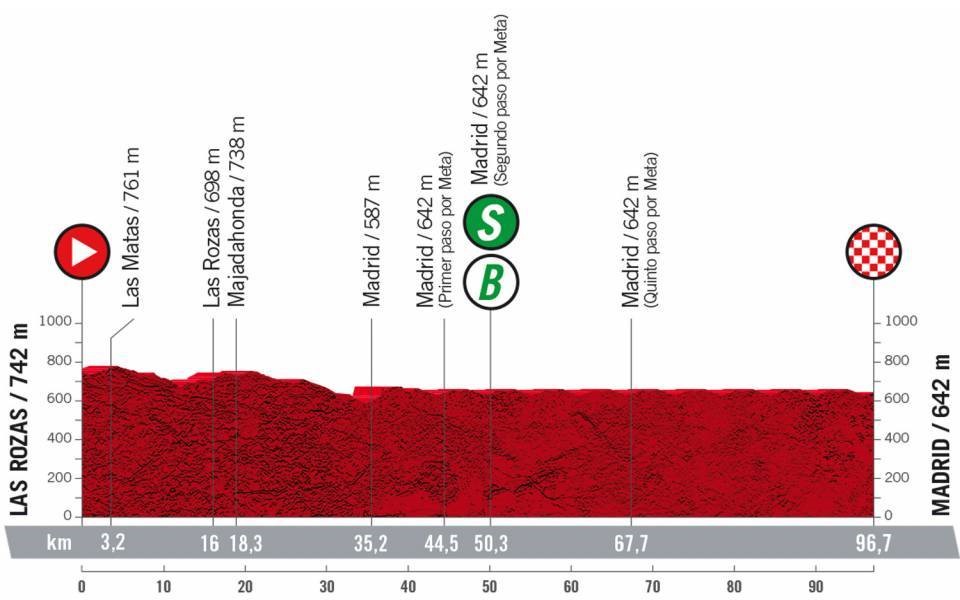
The processional ride into the Spanish capital culminates with five laps of the city-centre circuit where one remaining sprinter is likely to take the spoils and the best all-rounder will be crowned the overall winner.
– – –
Vuelta a España
Vuelta 2022 route: Climbs galore and the team time trial is back…
YESTERDAY AT 10:52
Vuelta a España
‘Everything starts again’ – La Vuelta is coming…
YESTERDAY AT 10:37
Read the full article Here


